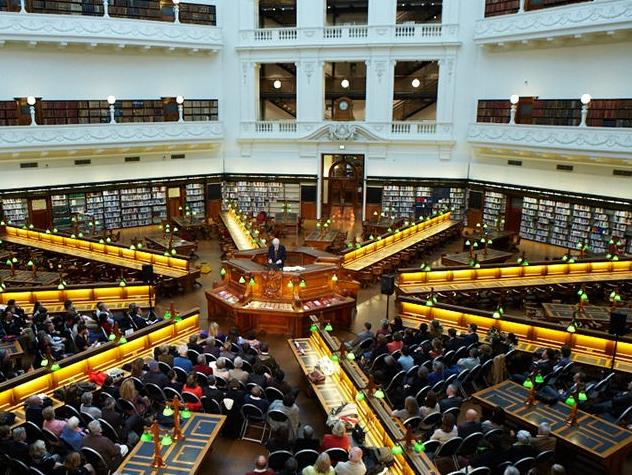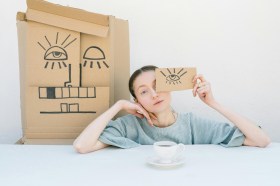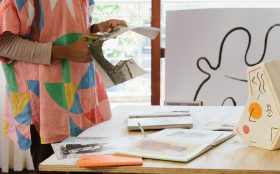The La Trobe Room at the State Library of Victoria is ever popular with visitors; courtesy SLV
In recent decades, the adage that libraries were on death’s door spread quickly in the wake of online publishing’s popularity and the subsequent release of Kindles and other hand-held devices. While most of us weren’t really taking such claims on board, libraries were. Their response was strategic and timely, and a key example of how to successfully pivot in the era of digital disruption.
Within a few short years, librarians reinvented what libraries were – and could be – in an information rich, experience-driven, interconnected future.
Testament to the rise of the 21st century library comes from an unexpected source. The hip international design blog Dezeen surveyed the most significant buildings to be unveiled in 2018. Among the top ten, three were libraries:
- Christchurch Central Library, New Zealand – designed by Schmidt Hammer Lassen Architects.
- Qatar National Library by the architectural firm OMA, headed up by Rem Koolhass.
- Calgary’s new Central Library and Library Place – designed by Snøhetta
Clearly, this is a vital and growing cultural space.
All three libraries profiled placed a pairing of technology and community facilities at the forefront of their designs, with their ground floors conceived as a continuation of public plazas, making the library a kind of permeable membrane to everyday life. Also key is the introduction of bespoke children’s libraries.
Speaking to a room full of technologists and cultural entrepreneurs at last year’s REMIX Summit – which ten years ago may have seemed an unlikely place to hear about libraries – Kate Torney, Director, State Library Victoria (SLV) said: ‘Libraries are thought of as cathedrals of books – and we love our books – but 21st century libraries are about more much than that …The library sector is one of few areas of the information sector that has absolutely thrived in the digital revolution.
‘The unexpected twist is that libraries have never been busier. Almost half of all Victorians are members of libraries and [at the SLV] we get two million visitors a year – that is more than British Library and more than the Library of Congress in Washington – and we get four million visiting our website as well,’ Torney added.
State Librarian of NSW (SLNSW), Dr John Vallance has observed a similar pattern. He told ArtsHub: ‘Libraries in general are developing in new ways to serve their communities. As fewer people go to church, and as the bank manager now lives in the cloud somewhere, the local library is for many people the one place where you can be safe and assured of a warm welcome. Because of this, we are seeing many of them, especially in regional areas, take on the character of the old “Schools of the Arts” in addition to their traditional functions.
‘Thirty years ago people were predicting the end of the library. Much as TV was supposed to replace radio, digital access was going to mean that physical libraries would be redundant. Completely wrong as it turns out. Across the world, and across NSW, new libraries are being built and old ones renewed,’ Vallance said.
So why the success? Why the investment in library infrastructure? And what does the library sector’s renewal mean to us, both as members of the public and as an arts sector?
Money speaks volumes
Just like the three multi-million dollar library developments listed by Dezeen, the SLV is in the midst of a $90 million redevelopment, which will open up 40% more space to visitors.
‘That is $60 million from the State Government and an extra $30 million that we are raising. Philanthropy and libraries don’t necessarily go together – museums and galleries are really great in those spaces but libraries have not been active in the philanthropic space with really big dollars,’ said Torney.
SLV hit its $27 million target three months ago. ‘There is a sense of confidence that the community and philanthropists saw in the future in libraries and role they have to play.’
Vallance explained that the SLNSW is also focusing on infrastructure. He said: ‘By the end of this year we hope to have doubled the space available for exhibitions, thanks to a creative collaboration between the NSW Government and a number of private philanthropists.’
‘Unique jewels from our art, photography, manuscript and printed book collections, together with some innovative digital experiments will give us a refreshed and renewed sense of our social history,’ he explained.
While this week Australia has been perplexed by the hyped word of the year, “Milkshake Duck”, Vallance said that 2018 at the SLNSW, ‘is brought to us by the letter “E” for “eviscerate”. We are turning our collections inside out, and putting our most valuable treasures on public display, in many cases for the first time.’
Torney also accounts the success as a grassroots one. Coming to the library from a background of 30 years in television she said she was blown away by the professionalism within the library sector. ‘Their success is about libraries quietly, and really, highly effectively adapting to meet changing needs of the public that they serve, but not in a top down approach.’
Transformation strategies in the library sector are very much bottom up, where change wells from the public’s questions over the counter with a librarian – a strategy which is clearly worth investing in, as the growth of new libraries indicates.
Winner of State Library Victoria and Redbubble collaboration, #CreateArtHistory, Natasha Sim talks about the impact of libraries
No longer hallowed edifices, but sites for partnerships
Torney said: ‘There are fewer and fewer places that people can use without a transaction to purchase something, or having to give something in return, so that is why I think libraries are going to be increasingly important.’
She spoke of Abe Nouk, the Sudanese refugee who only knew two words of English when he arrived in Australia, and who went on to win the title of National Australian Poetry Slam Champion for 2015.
‘He tells the story of his brother wagging school, saying that he’d found this amazing place where you can sneak in for free – before realising it was free. Abe learnt to read through children’s picture books as a teenager and went on to win Poetry Slam champion – seven years after arriving in Australia. Libraries do change lives,’ said Torney.
She said that if you were to visit the SLV at 11 o’clock on any day, it is currently very hard to find a space. ‘About a third of those people are under 30; what’s interesting is that is they are all highly connected but there is something about the physical connectivity of the library that they are wanting to be in the space.’
While libraries have traditionally been thought of places for research, today their function is incredibly layered. Family use has increased 200% in the past few years at SLV. Collections are being better activated – both digitally and through display.
‘At SLV we have a $300 million collection and we are very good at preserving and conserving it, but now we are really focused on sharing it,’ said Torney.
Vallance added: ‘The modern library does not face a binary choice between books or bytes – it must provide, curate and preserve both. Our experience of digitisation is more often than not that it whets people’s appetite for the real thing. In fact, the ready availability of new material in digital form means that we at the State Library of NSW can focus more than ever on the collection of unique, physical items relating to our own place in the world.’
Partnerships are proving to be a successful case studies for generating greater breadth and relevance.
Torney said: ‘We see partnerships as absolutely crucial. We are keen to talk about partnership ideas because we are keen to explore new ways of serving the public and new ways of thinking how we can bring our collections to life.’
Celebrating the soundscapes of Melbourne, The Australian Ballet collaborates with State Library of Victoria and Orchestra Victoria (2016).
SLV have lead the way with collaborations with Orchestra Victoria, The Australian Ballet, White Night and Redbubble – an online artists’ community and marketplace – with such organisations asked to respond to the library’s collection; and the creation of a new space called Start Space.
Torney explained: ‘What we have seen in libraries is a change in the kind of information people are seeking, and with the changing workforce we see there are a lot of start up spaces and co-working spaces in the inner city of Melbourne. They have table tennis tables and are really funky, but a lot of people who are starting their own business would be intimidated walking into those spaces – often they don’t even think of themselves as entrepreneurs.
‘The role of the library is a place where no question is dumb – where people can come in to develop their ideas – and what we see the library’s roles as doing is promoting that pre-entrepreneur stage, to support them as they develop their projects and before they move into that next tier of spaces.’
There is nothing stuffy, archaic or traditionally staid about that. Clearly, our perceptions of libraries need to catch up with their contemporary reality.
Torney said that when she announced to her 14-year old that she was moving from the ABC to the State Library, her daughter said, “Who leaves television to join a library?” Twelve months later her daughter called to ask for a lift home. ‘When I asked where she was, she said “at the library”. Yes had a win!’
Social media has played a huge role in shifting that perception, as have partnerships.
‘A 160-year-old institution being reinvented through new tech and social media is inspirational, and that history is driving a lot of our social popularity. The most popular [social media] posts by far are about that social history,’ said Torney.
Vallance added in conclusion: ‘Leading this kind of renewal is an exciting challenge. It involves a clear focus on service, broadminded and liberal support for an immense range of individual interests and attitudes, and a realisation that a good library in the 21st century will lie at the very heart of our civil society. A good library is for absolutely everyone.’
This conversation was in part drawn from the REMIX Sydney summit held at UTS in 7-8 December 2017.




